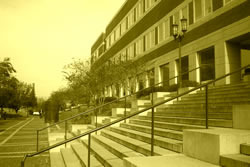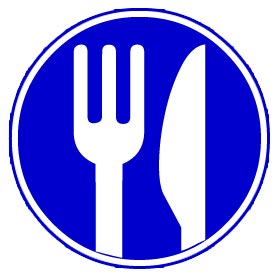|
|||||||
|
|
|
Home |

|
September 10th: Theories of DesignAnnouncements
Turn in Your Business Cards and Letterheads We have some design theories to go over, so please turn in your documents now, so you don't lose participation points for working on your assignments when you should be engaged in the conversation. Also, don't forget to turn in your memos with the documents. Plan for the Day We've got a few things to do today, so below is a list:
Theory There's quite a bit to say, so let's assess what we have time to discuss. Check out the page I have devoted to theory. As a preview, though, re-read the first page of Ch. 3 that claims theory attempts to explain "fundamental principles of human experience" (p.38). For our discussions, I want us to try to move beyond our immediate personal assumptions and be critical thinkers. Of course, there will be a multitude of interpretations for visuals, but we can find commonalities. Claiming that an interpretation depends on the "eye of the beholder" is accurate, but not looking beyond individual perspectives ignores prevailing attitudes that establish cultural generalizations. As designers, you have to "speak to me in a language I can hear" (Smashing Pumpkins), and that means following rules, conventions, and practices to meet audience expectations or just communicate effectively with audiences. I know it seems silly, but we actually perceive things based on light reflection and responses to visual stimuli. What we see is based on how our brains (through stimuli received by our eyes) interpret patterns of light. We distinguish colors, patterns, and entire objects through perceptions of light. While we could get very complicated in our discussions from biological perspectives, we won't go that far. Let's concentrate on what our textbook brought up. Some topics for us:
Being the cultural, social creatures that we are, much of our visual world is shaped by our experiences. I know some don't like to hear this, but we are rarely able to free ourselves from the cultures into which we're born. Even the choices you think you have are simply choices on a cultural menu, a grouping of ideas, values, practices, etc. that are socially constructed. A former professor of mine told our class that people hate being told that their culture is based on societal constructions and has no connection to absolute truth: (paraphrased from memory) "cultural pride deals in absolute value or worth—they don’t want to hear it’s contextual" (Thomas Van). But there's good news about cultural constructions and perceptions. Because members of a culture share commons backgrounds and ideologies, designers can tap into that shared knowledge. You might not be conscious of it, but, when you use idioms, refer to Entourage episodes, and use language, you're engaging in socially constructed activities. Some topics for us:
Ok, I know what you're thinking: Isn't rhetoric just BS...empty political speech? While empty political speech is a definition of rhetoric, it's too reductive a definition for enlightened college students such as yourselves. Rhetoric is much more involved than the unfortunate popular definition. For this class (and others) you should have a broader view of rhetoric. I like to define rhetoric as what builds meaning into something. That something can be an object, belief, event, or system, but, whatever it is, meaning is attached personally and culturally. Take the following words for example: Communism and Feminism. Both have denotations and connotations. The denotative definitions (from the dictionary) are below.
Connotations are the feelings, allusions, and values a group (such as a culture) associates with certain words. Likewise, rhetoric describes what gives messages (even visual ones) their meaning--explicitly and implicitly. Some topics for us:
Has anyone seen Super Size Me? Kids say the darndest things! In case I didn't show these already, let's take a look at a video and other visuals to help us think about Visual Perception, Visual Culture, and Visual Rhetoric. Ever wondered why video of TVs and computer monitors have a scrolling line? What hegemonic principles are at work in these images? What are the rhetorical attributes of the following images? In groups of 2, find an image and discuss its meaning in terms of culture or rhetoric. I realize that culturally defined meaning falls under "rhetoric," but, for tonight, try to separate the two. For instance, culturally, what can be said about this image: In American culture, we generally eat using these utensils. In fact, it's so common to think of a meal needing to be consumed using forks and knives, that the above is an index (but could be an icon for forks and knives) that refers to a place to eat--most likely a restaurant. Rhetorically, though, this "sign" follows the above described convention of eating with a fork and knife, but that doesn't immediately bring to mind persuasion. However, if the above sign were used by, say, a reviewer to point out favorable/popular restaurants, then we would claim the sign is an appeal to ethos because some critic established (and audiences agree) that the sign refers to good places to eat. Consider stars for rating the quality of a place (e.g., a 5-star restaurant is quite posh). Now, as you're driving down the highway (with your cell phone turned off), you may come to a blue sign with various smaller signs that refer to specific places (i.e., restaurants, gas stations, lodging, and attractions) usually with miles noted. I would say these are icons, but, considering the book's example of the restroom sign--possibly pointing to an actual restroom--being an index, I guess the restaurant images are also indexes. If you want to think further on this, check out the below links. Basically, know your audience. A lay audience with no knowledge of Saussure or Peirce isn't going to scoff at you equating icons with indexes. However, know that users should be able to quickly identify the meaning of an icon or index. Don't expect them to labor over the possible meanings; instead, ask "what does this icon or index immediately convey?" I know you all read Ch. 3 in The Non-Design's Design Book, so let's talk about that a bit. Thinking about our discussion above, what can we say about visual perception, visual culture, and visual rhetoric with regard to the chapter's guidelines? Keep up with the syllabus and read Ch. 4 in Document Design and Ch. 4 in The Non-Designer's Design Book for next week. Can you believe it's just two weeks before the midterm exam (9/24)? Unbelievable. Well, you have nothing to fear if you've been coming to class and reading. The midterm will focus mainly on the Document Design (Ch. 1-4) textbook, but there will be material from The Non-Designer's Design Book (Ch. 1-4). The exam's format will be multiple choice, fill-in-the-blank, and short answer. On the exam day, after you finish the exam, you can workshop Document #2: The Flyer OR Advertisement.
..
.. |
||||||||||||||||||||||||||||||||||||||||||||
|
|
|||||||||||||||||||||||||||||||||||||||||||||
| © UNC Charlotte Copyright | Privacy Statement | Page Maintained By: Aaron A. Toscano |

